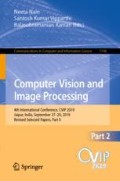Abstract
Weather nowcasting is a problem pursued by scientists for a long time. Accurate short-term forecasting is helpful for detecting weather patterns leading to extreme weather events. Adding the dimension of nowcasting to extreme weather prediction increases the ability of models to look for preliminary patterns ahead in time. In this paper, we propose a two-stage deep learning pipeline that fuses the usability of nowcasting to the high value of extreme events prediction. Our experiments are performed on INSAT-3D satellite data from MOSDAC, SAC-ISRO. We show that our pipeline is modular, and many events can be predicted in the second phase based on the availability of the relevant data from the first phase. Testing for extreme events like the Chennai floods of 2015 and Mumbai floods of 2017 validates the efficacy of our approach.
Access this chapter
Tax calculation will be finalised at checkout
Purchases are for personal use only
References
Darji, M.P., Dabhi, V.K., Prajapati, H.B.: Rainfall forecasting using neural network: a survey. In: 2015 International Conference on Advances in Computer Engineering and Applications, pp. 706–713 (2015)
Agrawal, K., Garg, S., Sharma, S., Patel, P., Bhatnagar, A.: Fusion of statistical and machine learning approaches for time series prediction using earth observation data. Int. J. Comput. Sci. Eng. 14(3), 255–266 (2017)
Jönsson, P., Eklundh, L.: TIMESAT - a program for analyzing time-series of satellite sensor data. Comput. Geosci. 30, 833–845 (2004)
Grover, A., Kapoor, A., Horvitz, E.: A deep hybrid model for weather forecasting. In: KDD (2015)
Zaytar, M.A., Amrani, C.E.: Sequence to sequence weather forecasting with long short-term memory recurrent neural networks. Int. J. Comput. Appl. 143(11), 7–11 (2016)
Hossain, M., Rekabdar, B., Louis, S.J., Dascalu, S.M.: Forecasting the weather of Nevada: a deep learning approach. In: 2015 International Joint Conference on Neural Networks (IJCNN), pp. 1–6 (2015)
Salman, A.G., Heryadi, Y., Abdurahman, E., Suparta, W.: Weather forecasting using merged long short-term memory model (LSTM) and autoregressive integrated moving average (ARIMA) model. JCS 14, 930–938 (2018)
Cracknell, M.J., Reading, A.M.: Geological mapping using remote sensing data: a comparison of five machine learning algorithms, their response to variations in the spatial distribution of training data and the use of explicit spatial information. Comput. Geosci. 63, 22–33 (2014)
Zhuang, W., Ding, W.: Long-lead prediction of extreme precipitation cluster via a spatiotemporal convolutional neural network. In: Proceedings of the 6th International Workshop on Climate Informatics: CI (2016)
Liu, Y., et al.: Application of deep convolutional neural networks for detecting extreme weather in climate datasets. CoRR. arXiv:1605.01156 (2016)
Ghaderi, A., Sanandaji, B.M., Ghaderi, F.: Deep forecast: deep learning-based spatio-temporal forecasting. CoRR. arXiv:1707.08110 (2017)
Racah, E., Beckham, C., Maharaj, T., Kahou, S.E., Prabhat, M., Pal, C.: ExtremeWeather: a large-scale climate dataset for semi-supervised detection, localization, and understanding of extreme weather events. In: Guyon, I., et al. (eds.) Advances in Neural Information Processing Systems 30, pp. 3402–3413. Curran Associates, Inc. (2017). http://papers.nips.cc/paper/6932-extremeweather-a-large-scale-climate-dataset-for-semi-supervised-detection-localization-and-understanding-of-extreme-weather-events.pdf
Shi, X., Chen, Z., Wang, H., Yeung, D.Y., Wong, W.K., Woo, W.C.: Convolutional LSTM network: a machine learning approach for precipitation nowcasting. In: NIPS (2015)
Klein, B.E., Wolf, L., Afek, Y.: A dynamic convolutional layer for short range weather prediction. In: 2015 IEEE Conference on Computer Vision and Pattern Recognition (CVPR), pp. 4840–4848 (2015)
Ronneberger, O., Fischer, P., Brox, T.: U-Net: convolutional networks for biomedical image segmentation. In: Navab, N., Hornegger, J., Wells, W.M., Frangi, A.F. (eds.) MICCAI 2015. LNCS, vol. 9351, pp. 234–241. Springer, Cham (2015). https://doi.org/10.1007/978-3-319-24574-4_28
Batson, J., Royer, L.: Noise2self: blind denoising by self-supervision. arXiv preprint arXiv:1901.11365 (2019)
Mao, X., Shen, C., Yang, Y.B.: Image restoration using very deep convolutional encoder-decoder networks with symmetric skip connections. In: Advances in Neural Information Processing Systems, pp. 2802–2810 (2016)
Kumar, P., Varma, A.K.: Assimilation of INSAT-3D hydro-estimator method retrieved rainfall for short-range weather prediction. Q. J. R. Meteorol. Soc. 143(702), 384–394 (2017). https://doi.org/10.1002/qj.2929
Agostinelli, F., Anderson, M.R., Lee, H.: Adaptive multi-column deep neural networks with application to robust image denoising. In: NIPS 2013 (2013)
Wikipedia Contributors: 2015 south Indian floods – Wikipedia, the free encyclopedia (2019). https://en.wikipedia.org/w/index.php?oldid=896549980. Accessed 11 May 2019
Wikipedia Contributors: 2017 Mumbai flood – Wikipedia, the free encyclopedia (2018). https://en.wikipedia.org/w/index.php?oldid=864880459. Accessed 11 May 2019
Acknowledgements
This work was supported by the Satellite Meteorology and OceAography Research and Training (SMART) program at Space Application Centre, ISRO. We are thankful to SAC-ISRO for providing delightful opportunity and also giving us the relevant data and facilitating environment.
Author information
Authors and Affiliations
Corresponding author
Editor information
Editors and Affiliations
Ethics declarations
Conflict of Interest
The authors declare that they have no conflict of interest.
Rights and permissions
Copyright information
© 2020 Springer Nature Singapore Pte Ltd.
About this paper
Cite this paper
Oza, V., Thesia, Y., Rasalia, D., Thakkar, P., Dube, N., Garg, S. (2020). Extreme Weather Prediction Using 2-Phase Deep Learning Pipeline. In: Nain, N., Vipparthi, S., Raman, B. (eds) Computer Vision and Image Processing. CVIP 2019. Communications in Computer and Information Science, vol 1148. Springer, Singapore. https://doi.org/10.1007/978-981-15-4018-9_25
Download citation
DOI: https://doi.org/10.1007/978-981-15-4018-9_25
Published:
Publisher Name: Springer, Singapore
Print ISBN: 978-981-15-4017-2
Online ISBN: 978-981-15-4018-9
eBook Packages: Computer ScienceComputer Science (R0)

